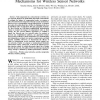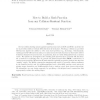157 search results - page 12 / 32 » Counteracting Oracle attacks |
ESORICS
2005
Springer
14 years 27 days ago
2005
Springer
Abstract. Formal methods have been extensively applied to the certification of cryptographic protocols. However, most of these works make the perfect cryptography assumption, i.e....
JSAC
2006
13 years 7 months ago
2006
Abstract-- Node compromise is a serious threat to wireless sensor networks deployed in unattended and hostile environments. To mitigate the impact of compromised nodes, we propose ...
ASIACRYPT
2007
Springer
14 years 1 months ago
2007
Springer
We show that computing e-th roots modulo n is easier than factoring n with currently known methods, given subexponential access to an oracle outputting the roots of numbers of the ...
CRYPTO
2005
Springer
14 years 27 days ago
2005
Springer
The Full-Domain Hash (FDH) signature scheme [3] forms one the most basic usages of random oracles. It works with a family F of trapdoor permutations (TDP), where the signature of m...
ASIACRYPT
2007
Springer
14 years 1 months ago
2007
Springer
Recent collision-finding attacks against hash functions such as MD5 and SHA-1 motivate the use of provably collision-resistant (CR) functions in their place. Finding a collision ...


